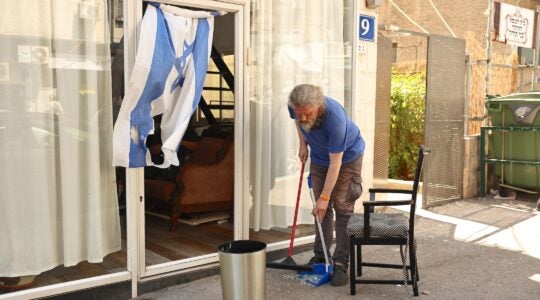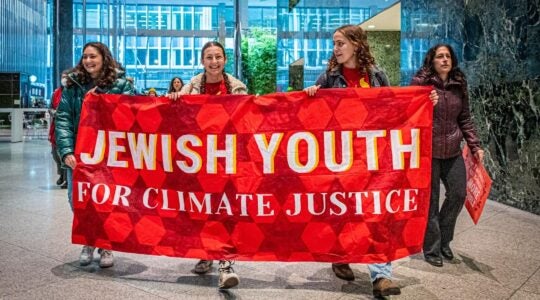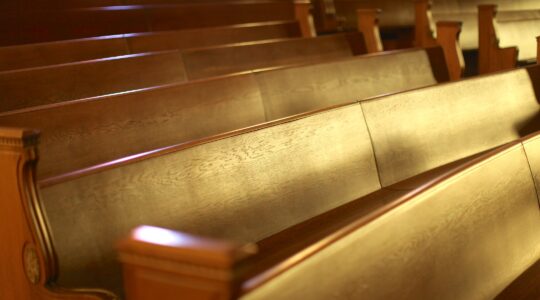JTS Chancellor Arnold Eisen’s Opinion essay, “What It Means To Be Jewish Today”, requires a response because it avoids the elephant in the room regarding our shared concern about a disappearing American Jewry.
Dr. Eisen is an insightful analyst of American Jewish life, but he offers no new solution to the problem he accurately diagnoses. Dr. Eisen understands that non-Orthodox American Jews are more distant than ever before from historic institutions such as the synagogue and that, as he writes, “assimilation will take its toll.” His prescription is an all too common current suggestion to consider the role social networking and other smaller permutations of community might play in connecting Jews to each other within some vestige of community. Dr. Eisen concludes by stating that quality trumps quantity —≠ that in terms of the committed remaining few, such as the remnant of observant Conservative Jews he guides as Chancellor of the historic Jewish Theological Seminary, quality is “more important to Jewish survival than mere numbers.”
The missed opportunity of American Judaism is that the most favorable moment to develop a rich and vibrant communal life in the narrative of the Jewish diaspora has become a story of ethnic attrition.
That speculative position of quality over quantity offers no solace. The missed opportunity of American Judaism is that the most favorable moment to develop a rich and vibrant communal life in the narrative of the Jewish diaspora has become a story of ethnic attrition. If only a few survive, then American Jewry becomes a museum curiosity consisting of just its own most committed base, quickly losing its place as a normative mainstream faith community offering a meaningful degree of spiritual and moral value for its own members and to the polis at large. While activists from the extreme base on any side may abound, gone are the central communal figures such as Stephen Wise or Abraham Joshua Heschel. We are left with a tiny band of partisan activists that most American Jewish families do not know of.
Save for a small Orthodoxy minority numbering not much more than 10 percent of U.S. Jewry, American Jews have overwhelmingly decided not to marry each other and commit their children to serious Jewish education or communal commitment. With more than 70 percent of American Jews marrying non-Jews according to the most current Pew Research Center Survey of U.S. Jews, and the minority of non-Orthodox Jews who do marry Jewish partners not providing substantive and consistent Jewish exposure to their children, it is hard to see how American Judaism will survive in any meaningful way outside of Orthodoxy. Therefore, the elephant in the room that Dr. Eisen does not face, is that two, and only two, choices remain for the organized Jewish community: to completely rethink and then quickly implement a radically new kind of American Judaism that meets the people where they are now, or give up and focus all communal energy and resources on Orthodoxy, which at least is suffering no attrition, has the highest Jewish birthrate, and is the most communally active of all the movements, meeting Dr. Eisen’s criteria of quality over quantity.
Both options are stark, but they honestly represent the plain reality of the communal fork in the road we are at today. Rethinking American Judaism is likely the harder of the two options. It means that ideologies nurtured over generations have to be shed. Synagogues have to be completely reconceived, which means a whole bureaucracy and professional class is placed in flux. Furthermore, rituals have to be reformulated, too. Two and three generations ago the late Friday night service was a popular innovation. It attracted rapidly Americanizing Jews into sacred spaces to sustain core rituals such as Shabbat song and Kiddush. Perhaps now there should be a focus on reaching out to American Jewry around Chanukah and Passover, two still widely observed Jewish holidays. One idea is that there can be outreach tours by, say, students at Dr. Eisen’s institution, to visit Jewish communities and hold family events in public and pop up private spaces around these celebrations.
Regardless of any policy adopted, something’s got to give, or all but the tiniest amount of flagship non-Orthodox religious institutions will survive. It’s really that simple.
If the second choice is made to divert communal support more and more towards the Orthodox sector, we are guaranteeing the continuity of a strong, albeit less populous, American Jewry. This strategy fits neatly within Dr. Eisen’s suggestion arguing quality over quantity in terms of Jewish commitment mattering more than demographics. As an Orthodox Rabbi, I have a natural propensity to support that possibility. But, I am also a political scientist, and I recognize that, when it comes to institutional success, numbers matter. Volume can speak truth to power, and so I recognize that not all American Jews are going to become observant. But I also know that I am part of a community from which many lessons can be learned regarding American Jewish survival. I write that not as a triumphalist, but as a realist. Orthodoxy makes all-encompassing demands on its adherents’ lifestyles, individually and collectively. It shares across its diverse spectrum a fundamental communal unity when it comes to its core values and causes, such as day school tuition tax credits and vouchers. Liberal Jews need not share Orthodoxy’s convictions, but they can share Orthodoxy’s sense of overriding collective unity and seriousness. The truth is that leaders such as Dr. Eisen have to figure that out quickly, or they will have no one left to lead, and that will be a tragedy for us all.
Rabbi Dr. Abraham Unger is associate professor of government and politics at Wagner College in Staten Island. His newest book, “A Jewish Public Theology: G-d and the Global City” (Lexington Books, an imprint of Rowman & Littlefield), is due out in November. He is rabbi of Congregation Ohav Zedek in Bayonne, N.J.
The New York Jewish Week brings you the stories behind the headlines, keeping you connected to Jewish life in New York. Help sustain the reporting you trust by donating today.




